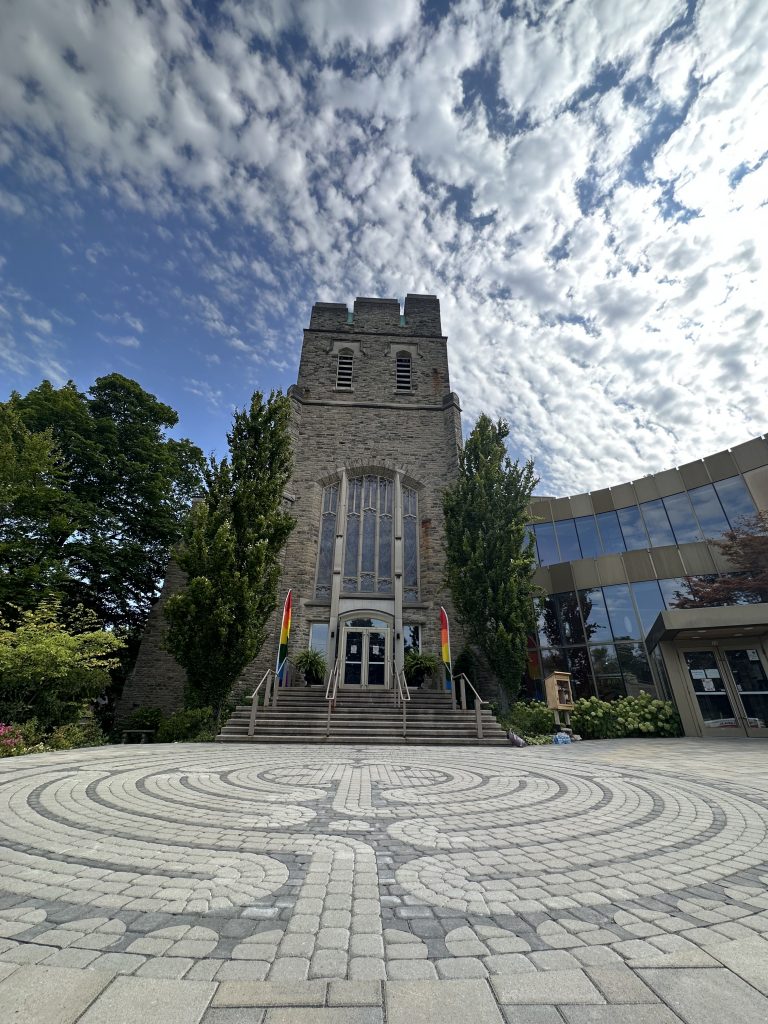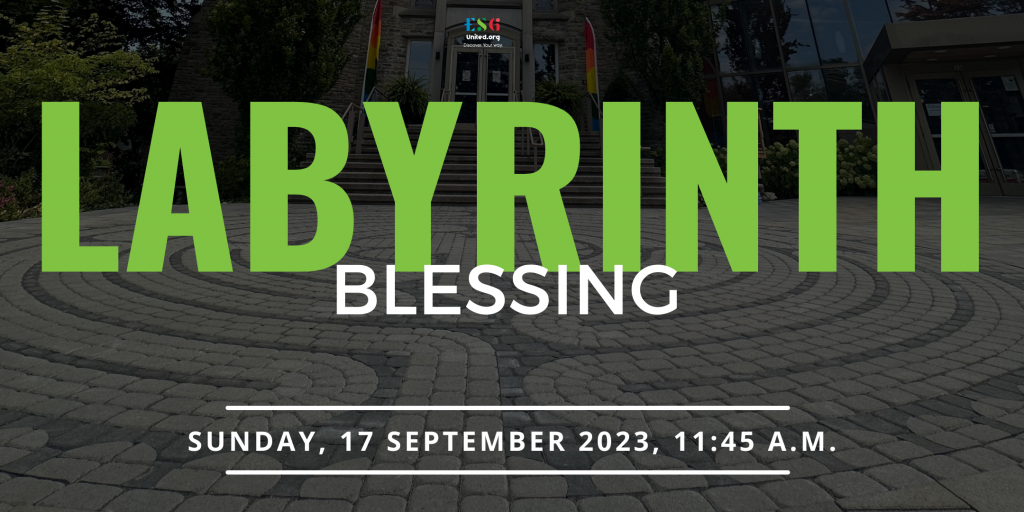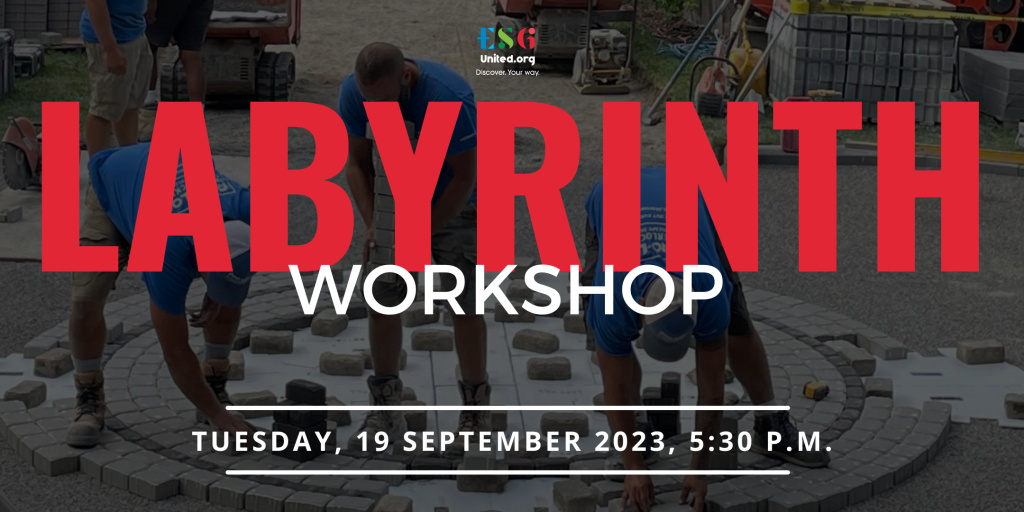Eglinton St George’s New Outdoor Labyrinth

“Although we walk all the time, our walking is usually more like running. When we walk like that, we print anxiety and sorrow on the earth. We have to walk in a way that we only print peace and serenity on the earth. When we are able to take one step peacefully and happily, we are working for the cause of peace and happiness for the whole of humankind.”
(Thich Nhat Hanh, Peace is Every Step)
Why Walk a Labyrinth
The labyrinth is an ancient pattern found in many cultures around the world. Labyrinth designs were found on pottery, tablets and tiles which date as far back as 4000 years. Many patterns are based on spirals from nature. In Native American culture it is called the Medicine Wheel and Man in the Maze. The Celts described it as the Never-Ending Circle. It is also called the Kabala in mystical Judaism. One feature they all share is that they have one path which winds in a circuitous way to the center. Unlike a maze, labyrinths have a singular path and there are no dead ends or diverging paths.
Labyrinths have been used by thousands of generations of people as a means of tapping into the sources of wisdom within each of us. Their prominence has come and gone over the centuries, and they seem to reappear in times of difficulty and unusual stress. It is an especially valuable gift to soothe our spirits and find our way back to the quiet centre.
The Reverend Dr. Lauren Artress came across labyrinths in the early 1990’s and she had such profound experiences walking the labyrinth that it became her life’s work and passion to reintroduce the world to the value and beauty of labyrinths. She founded Veriditas, a non-profit organization to spread information about the important usefulness of labyrinths in today’s world. Many labyrinths have been created worldwide due to her efforts, and since Covid-19, the interest in labyrinths has increased significantly. She says, “The labyrinth is a spiritual tool that has many applications in various settings. It reduces stress, quiets the mind and opens the heart. It is a walking meditation, path of prayer, and a blueprint where psyche meets Spirit.” Labyrinths appeal to all races, to all religions, and are a uniting force to create peace and comfort in our troubled world.
Each person’s experience on the labyrinth is unique and personal, and as such, it is open and welcoming to everyone.
- In our busy, non-stop world, we often need help to calm our brains. Walking the labyrinth requires focus and provides a sense of measured calm and tranquility. The slowness of the walk allows the mind to adjust to the speed of the body. As your body stops rushing, your thoughts also quieten.
- For some, in a place of deep sorrow, the walk gives solace and peace
- For others, going through a life transition, it offers clarity and calm
- It is a guide for healing and deepening self-knowledge
- For some, it is a way to connect to God and one’s deep spiritual longing.
- It helps one to see their life as a path or pilgrimage
- It helps to awaken untapped gifts and stirs creativity
How to Walk a Labyrinth
Every labyrinth walk is different. You may feel nothing or have a powerful reaction. Be open to experience whatever comes for you. Unlike a maze, there is only one path in and out, no way to get lost or trapped. Trust that the path guides you. Surrender and let go.
There are three stages to walking the labyrinth
Releasing: Walking into the labyrinth
This is the time to quiet the mind, let go of the details, distractions, and extraneous thoughts.
Open your mind and heart. Become aware of your breathing. Relax and find your natural pace. Notice how the path twists and turns.
Receiving: Pausing in the Centre
Stay open to receiving throughout the walk. You might choose to pause in the centre to reflect, meditate, or pray. Receive what is there for you to receive.
Returning: Walking out of the labyrinth
Follow the path back out. Sometimes integration of your experience can occur.
Tips for Walking the Labyrinth
- Consider setting an intention or posing a question before you start your walk
- You might want to bring a notepad and pen with you to write down thoughts and insights as they arise
- Feel free to move around others or let others move around you. Each person finds their own comfortable pace
- The path is a two-way street. You will meet people coming out as you go in. Do what feels natural when you meet
- Let your gaze be soft as you walk
- It is a walk for all ages
- Enjoy the journey!
A labyrinth is a walking meditation, a crucible of change, a watering hole for the spirit and a mirror of the soul. May you be nourished.
Our Labyrinth Expert: Cathie Stewart
Cathie Stewart, CPA-CGA, gained valuable experience as a business entrepreneur and over time, she discovered her passion for working with people one-on-one. In 2016, Cathie travelled to Chartres, France where she completed the Veriditas labyrinth facilitator training with the founder of Veriditas, Lauren Artress. She was inspired by the personal transformation that she experienced through the Veriditas workshops and has continued to participate in many enriched programs. She leads workshops to introduce people to the mystical, inspiring world of labyrinths and how one can get the most benefit from the labyrinth walking experience. She also leads a morning meditation group and enjoys helping people with their spiritual growth.

Labyrinth Events
Blessing of the Labyrinth

Date: Sunday, September 17
Time: 11:45 a.m.
Location: 35 Lytton Boulevard, Toronto, ON M4R 1L2
Labyrinth Walking Workshop

Join us in this ancient space of refuge and renewal
Date: Tuesday, September 19th, 2023
Time: 5:30-7:00 p.m.
Location: 35 Lytton Boulevard, Toronto, ON M4R 1L2
Cost: $15
Workshop: An Introduction to the Labyrinth
Join experienced facilitator Cathie Stewart as she guides you through the labyrinth experience. She will explain in depth:
· what a labyrinth is
· how to walk it
· the history behind it
· the benefits of walking the labyrinth
· the impact of labyrinth walks in different groups including prison settings, hospital groups, school age children, and people of differing abilities

